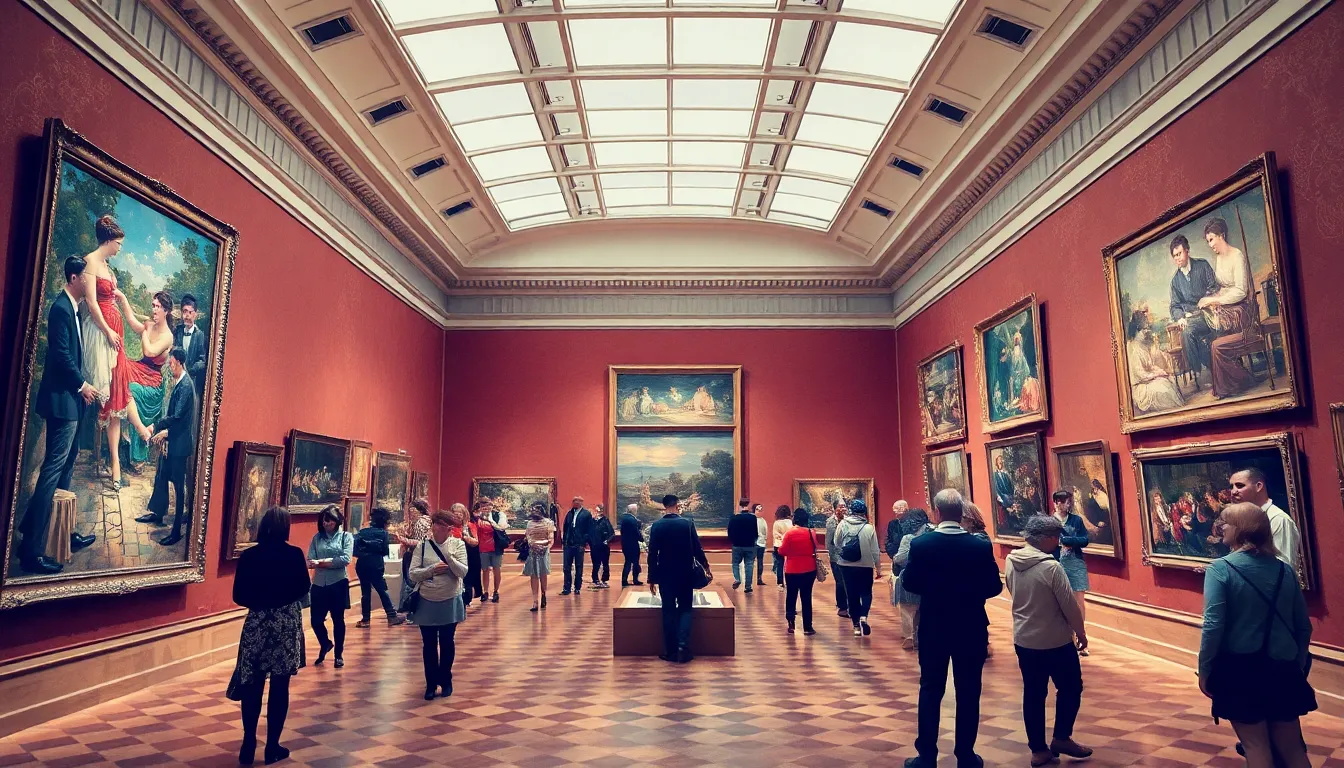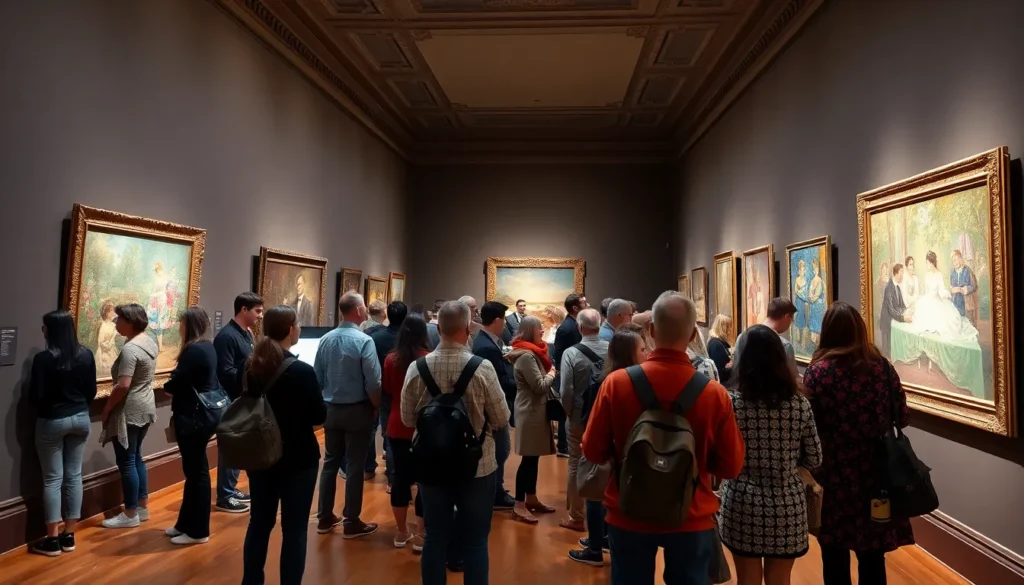Imagine stepping into a world where colors dance and brushstrokes tell stories—welcome to the National Gallery of Art’s Impressionist exhibit. This isn’t just an art display; it’s a vibrant journey through time that’ll have you questioning if you’ve accidentally stumbled into a Monet masterpiece.
Table of Contents
ToggleOverview of the National Gallery of Art Impressionist Exhibit
The National Gallery of Art’s Impressionist exhibit showcases a remarkable collection of late 19th-century artworks. Visitors experience a vibrant array of paintings by renowned artists like Claude Monet, Edgar Degas, and Pierre-Auguste Renoir. Each piece invites onlookers to explore the innovative techniques that defined the Impressionist movement.
Visitors encounter works that highlight the evolution of light and color in art. The exhibit includes over 100 pieces, presenting a diverse representation of landscapes, portraits, and urban scenes. Special attention is given to Monet’s water lilies, which capture the beauty of nature and emotion.
Curators carefully arrange the artworks to create thematic sections. These sections guide attendees through the historical context and techniques of Impressionism. Descriptive labels accompany each painting, offering insights into the artists’ intentions and influences.
Interactive elements enrich the visitor experience. Multimedia displays provide background information on the lives and works of the featured artists. Guided tours enhance understanding of Impressionist techniques and their impact on modern art.
Special events, including lectures and workshops, reflect the gallery’s commitment to education. Artists and scholars share their knowledge of Impressionism during these events, allowing for deeper engagement.
Overall, the National Gallery of Art Impressionist exhibit serves as a gateway to experiencing transformative art. It’s an opportunity to appreciate the mastery of color and light that remains influential today.
Featured Artists

The Impressionist exhibit at the National Gallery of Art features iconic artists known for their revolutionary approaches to light and color. Each artist’s work provides insight into the transformative nature of this art movement.
Claude Monet
Claude Monet remains a central figure in Impressionism. His famous series on water lilies illustrates the interplay of light and water, showcasing the changing reflections and colors that captivated him. The exhibit includes several works that reflect his obsession with capturing nature’s fleeting moments. Notably, Monet’s paintings invite viewers to experience the serenity and beauty of his garden at Giverny.
Edgar Degas
Edgar Degas stands out for his unique portrayal of movement and human figures. His depictions of ballet dancers highlight grace and hustle within the world of performance. The exhibit features various pastels and paintings, emphasizing Degas’s fascination with capturing the dynamics of dance. Each piece encapsulates a fleeting moment, inviting viewers into the vibrancy of late 19th-century Parisian life.
Pierre-Auguste Renoir
Pierre-Auguste Renoir’s works celebrate the joy of life and the beauty of social gatherings. His vibrant color palette and soft brush strokes create a sense of warmth and intimacy, evident in his depictions of lovers, friends, and family. The exhibit showcases several masterpieces that exemplify Renoir’s ability to convey emotion and atmosphere. Each painting encapsulates the lively spirit of outdoor gatherings and the simple pleasures found in companionship.
Highlighted Paintings
The National Gallery of Art’s Impressionist exhibit features a diverse selection of stunning artworks. This showcase includes pieces that capture the essence of the Impressionist movement, highlighting both iconic and lesser-known examples.
Iconic Works on Display
Claude Monet’s “Water Lilies” stands out as a centerpiece, demonstrating his mastery of color and light. This series invites viewers into a serene world where reflections dance across the water. Edgar Degas’s “The Ballet Class” captivates with its dynamic portrayal of dancers, illustrating the energy of movement and elegance. Pierre-Auguste Renoir’s “Luncheon of the Boating Party” immerses visitors in a joyful social scene, using vibrant hues to showcase warmth and camaraderie. These iconic works represent the pinnacle of Impressionist creativity, drawing art enthusiasts from around the world.
Lesser-Known Gems
Among the lesser-known artworks, Berthe Morisot’s “Summer’s Day” enchants with its delicate brushwork and innovative composition. This piece captures a moment of leisure, highlighting Morisot’s unique perspective within the movement. Alfred Sisley’s “The Bridge at Villeneuve-la-Garenne” offers a tranquil riverside view, reflecting Sisley’s exceptional talent for depicting landscapes. Camille Pissarro’s “The Red Roofs, OSny” draws attention with its vibrant colors and rural charm, showcasing the beauty of everyday life. Each of these gems enriches the visitor’s understanding of Impressionism, revealing the depth and variety within the genre.
Visitor Experience
The National Gallery of Art’s Impressionist exhibit offers a rich and engaging visit. Designed to captivate art lovers, the exhibition layout enhances the visitor’s journey through carefully curated thematic sections.
Exhibition Layout
Curators organized the artworks into distinct themes. Each section connects artworks reflecting a specific aspect of the Impressionist movement. Visitors experience a seamless flow from one theme to another, creating a narrative that highlights the evolution of light and color. Artistically displayed, pieces like Monet’s water lilies and Degas’s ballet dancers share wall space, allowing attendees to appreciate contrasts and similarities. The layout encourages visitors to linger and explore while enjoying optimal visibility for each artwork. Overall, this thoughtful arrangement fosters deep engagement with the masterpieces on display.
Educational Resources
Educational resources add value to the experience at the exhibit. Descriptive labels accompany each artwork, providing historical context and insight into the artists’ intents. Multimedia displays offer engaging ways to learn about Impressionism. Informative pamphlets feature additional details about the artists and specific works. Guided tours lead visitors through the exhibition, enriching understanding through expert commentary. Special events like workshops and lectures deepen appreciation for the art form while encouraging dialogue among attendees. Overall, these resources turn a simple visit into a comprehensive learning experience.
The National Gallery of Art’s Impressionist exhibit stands as a testament to the enduring impact of this revolutionary art movement. Through its remarkable collection and thoughtfully curated themes, visitors are invited to experience the brilliance of artists like Monet, Degas, and Renoir in a way that transcends mere observation.
Interactive elements and educational resources further enrich the experience, making it accessible to both seasoned art enthusiasts and newcomers alike. This exhibit not only showcases the beauty of Impressionism but also fosters a deeper understanding of its historical significance. As visitors immerse themselves in the vibrant world of color and light, they’ll discover the lasting legacy of these iconic artists in shaping the future of art.










